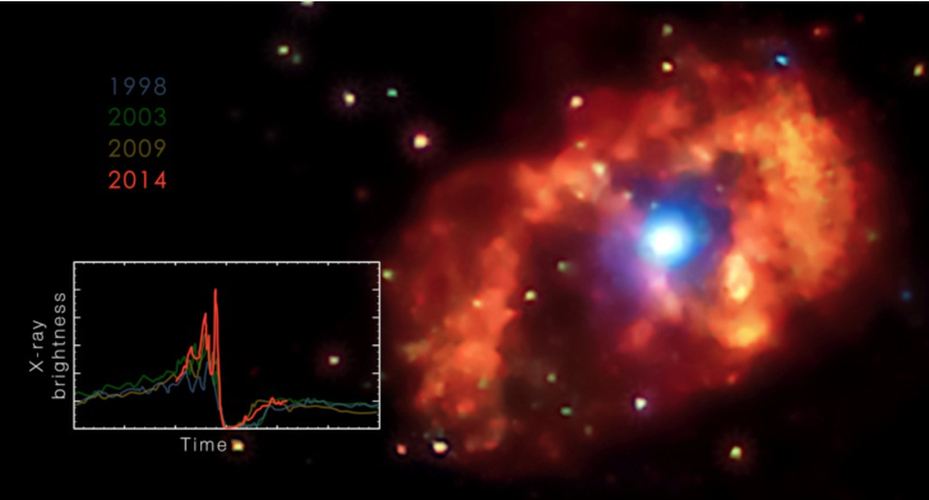
 Credit: NASA's Goddard Space Flight Center/M. Corcoran
Credit: NASA's Goddard Space Flight Center/M. Corcoran
A Near Miss
Stars are gregarious, and they like to form tight relationships with other stars. A surpisingly large fraction of the known stars have gravitationally-bound companion stars, and this is especially true for more massive stars. The most massive and most luminous star within 10,000 lightyears of earth is the star called Eta Carinae. Eta Carinae, or Eta Car for short, is a rather mysterious stellar monster with a violent temper. It's notorious for popping off in the mid-19th century in a famous event which has come to be called the "Great Eruption", an explosion whose energy rivaled a supernovae. Though this explosion did tremendous damage to the star, Eta Car nevertheless survived. Eta Car is shrouded by the dusty debris from this explosion, which makes the star itself tantalizingly hard for astronomers to study. In the 1990's, observations of the infrared and X-ray emission from Eta Car showed a peculiarly stable variability period of five and a half years. The X-ray variability of Eta Car is very similar to that of WR 140, a massive, long period binary star with a very elliptical orbit. This similarity lead astronomers to realize that Eta Car is also a long period, eccentric binary system whose X-ray variation is driven by the collision of the stellar wind of Eta Car against the wind of the companion star. Every 5.5 years this companion comes close to, and almost skims the surface of, Eta Car, causing extreme variability which can be seen from radio waves to Gamma-rays. The image above is a still from an animation simulating the X-ray variation of Eta Car over nearly 20 years, based on observations with the Rossi X-ray Timing Explorer and the Swift X-ray Telescope. The image on the right is an X-ray image from the Chandra X-ray Observatory showing the extended X-ray emitting gas in red produced by the collision of the debris from the Great Eruption with interstellar gas, along with the bright, high-energy X-ray emission produced by the central binary system. The inset image shows the X-ray brightness of the star measured by RXTE and Swift. The emission from the central binary in the image is varied to show how the X-ray emission from the binary star drops around the time of closest approach. The most recent X-ray minimum state occured this past August. At some time in the not too distant future, Eta Car will die, but exactly when or how is unclear - uncertainties which cause some astronomers to call Eta Car "our biggest embarrassment today".
Published: January 19, 2015
<
HEA Dictionary ● Archive
● Search HEAPOW
● Other Languages
● HEAPOW on Facebook
● Download all Images
● Education ● HEAD
>

Each week the HEASARC
brings you new, exciting and beautiful images from X-ray and Gamma ray
astronomy. Check back each week and be sure to check out the HEAPOW archive!
Last modified Tuesday, 27-Feb-2024 10:10:04 EST


